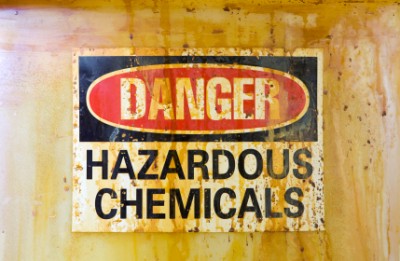The jury has been out for quite some time on chemical fertilizers and herbicides – are they good or bad? Roundup, which is the most popular weed killer in the U.S., is at the center of the debate. Researchers in Europe have claimed that the weed killer has serious toxic effects. This, they say, is due to inert ingredients that amplify the toxicity of Roundup’s active ingredient, glyphosate. As a result, Roundup is banned in nearly every European country.
Research On Roundup
Suburbanites all across the country have heard the warnings about chemical herbicides, yet many still ignore the full implications of their use. Mr. Weekend Warrior’s main concern is whether his front lawn is greener than his neighbor’s. Caring about what’s in the product that makes him win this competition is of little importance to him as he stands there beaming with pride! But farmers and homesteaders are different, aren’t we?
Let’s first look at the active ingredient in nearly all chemical herbicides: glyphosate. On its own, glyphosate contains an “acceptable” level of toxicity for use around humans. This is according to testing carried out by our friends at the EPA. However, European researchers claim that previous testing was conducted on glyphosate alone, and did not take into account the combined ingredients found in Roundup and other weed killers. One ingredient in particular, polyethoxylated tallowamine (POEA), gave researches the most cause for concern.
In tests, researchers used concentrations at much higher dilution than used in normal applications of Roundup. Their results showed that the concentration damages DNA and caused birth defects in laboratory animals. The researchers have also linked higher rates of cancer and birth defects in areas of South America growing genetically modified food, which is specifically tolerant to the use of Roundup. Since the initial research, further reports have been released and the EU is set to review the case some time in 2012.
While the risk to human health is being debated, there is also the impact of Roundup on soil and crops to consider. Separate research has concluded that rather than helping crops to thrive, Roundup kills essential nutrients and leaves plants vulnerable to disease. Some of the issues cited are prevention of photosynthesis, reduced water efficiency, lower lignin content, compromised root systems, and adverse affects on soil pH. Fungal pathogens, however, are said to be on the rise, causing an increase in toxins that are potentially harmful to humans and livestock. Researchers also say claims that glyphosate breaks down in soil are untrue; with some reports estimating that the half-life of glyphosate is as high as twenty-two years.
All of this means that with each application, glyphosate and other toxic ingredients further damage soil and contaminate clean water sources. There are serious concerns that continued use of Roundup will irreversibly reduce the presence of essential nutrients and minerals, in both the animal and human food chain. For further information on the effects of glyphosate and Roundup on soil, plants, animal and human health, The Institute for Responsible Technology has compiled a comprehensive list of resources.
New Natural Fertilizer Doubles Garden Production!
Research On Chemical Fertilizers
Another cause for concern in the agricultural community is the use of chemical fertilizers. Unlike their organic counterparts, chemical fertilizers do not contain the important micronutrients that crops and soil need. Excessive use results in the depletion of microorganisms and nutrients in soil, which eventually leaves land barren and un-farmable. Chemicals are also contained in crops, which then make their way into the animal and human food chain, causing potential health risks when eaten. Much like chemical pesticides and herbicides, the ingredients in these fertilizes contaminate water sources, increasing enrichment of ponds, rivers, and lakes. High levels of toxic metals found in chemical fertilizers are believed to be the highest contributing factor in water pollution. Lead, cadmium, and chromium are found in many chemical fertilizers; however, fertilizer labeling laws do not require that they are listed as ingredients.
In the early part of the last decade, a report revealed that from 1990 to 1995, 600 different companies from 44 of the 50 states sent a whopping 270,000,000 pounds of toxic waste to both fertilizer companies and farms. Most of this waste came from the steel industry, mainly due to the inclusion of zinc, which is an important nutrient for plant growth. However, the waste was not treated to remove other toxic substances including arsenic and dioxins.
Fast forward to the present day, and these chemical fertilizers are still linked to myriad problems, including:
- Birth defects
- Kidney damage
- Liver damage
- Blue baby syndrome
- Reproduction issues
- Reduced immune response
Dioxin levels are high in many chemical fertilizers, which is the main cause of concern for researchers and opponents. Due to highly toxic potential, dioxins are known to affect a number of organs and systems in both humans and animals. Another ingredient that has sparked concern is 2,4-D, the active ingredient in combination weed killers and fertilizers. 2,4-D is also the active ingredient in Agent Orange, which was specifically designed to destroy crops and leave farmland barren in Vietnam during the war. Back in February of this year, the Natural Resources Defense Council sued the EPA, citing that they (the EPA) failed to respond to a 2008 petition that sought to revoke the use of the chemical. Studies are ongoing; however, the claims that these chemicals do not pose a serious threat to human health have by no means been proven to the satisfaction of independent researchers.
The Secrets Of Sea Minerals To Grow More “Nutritionally-Dense Food” Than You Can Possibly Eat!
Organic Alternatives – Weeding
In response to these damning reports, there has been a huge upsurge in the production of organic alternative herbicides. However, sometimes the old methods still work best. Yes, herbicidal soaps work well on weeds and do not present the same adverse affects on crops, animals, or the environment. However, a 20-80 solution of vinegar and water will also work well on younger weeds. Good old-fashioned mulch is another method that will keep the weeds at bay. Corn gluten meal, which will not affect plants that have already sprouted, kills seedling roots and prevents the weed from growing.
Burning weeds is a popular method of control among many homesteaders; however, it goes without saying that extra care is required. You do not need to set the plant on fire; the heat alone will cause the cells to explode and kill the plant. Do not attempt to burn weeds in high winds, always carry a bucket of water with you to control fires, and, be careful around fences and other flammable materials. Before burning weeds on your land, make sure that you check local regulations for setting fires too.
Undoubtedly the oldest weed control method of all is hard work and a bit of elbow grease. All you need is a machete or similar cutting tool and the willingness to get out and get your hands dirty. Not to mention that pulling weeds is a much healthier alternative to breathing in and consuming harmful chemicals.
Organic Alternatives – Fertilizer
There are so many organic alternatives for fertilizer that it is a wonder chemicals are used at all. Organic options differ only in what they provide to crops and soil. Depending on your needs, there are a number of natural fertilizers that will keep your crops and soil healthy and strong. Nitrogen, phosphorus, and potassium are essential to healthy plants, crops and soil. A great source of all three is blood, fish, and bone fertilizer. Not only does it provide the essential nutrients that plants need, it is perfect for improving soil fertility as well. Bone meal actively promotes root growth, so it is ideal for sprinkling in holes prior to planting.
Other organic fertilizers include Epson salts for magnesium, rock phosphate to promote rooting, and seaweed meal as a slow release fertilizer. It is important to use the right organic fertilizer under the right conditions. King Henry’s Walk Garden provides a full list of naturally occurring fertilizer ingredients and their benefits. The best sources for manure are cows, horses, sheep, pigs, goats, and poultry. However, each has its own distinct benefits to plants and soil. Cow and horse manure are best for flowers and should be applied in early spring. For potato or root crops use chicken, cow, or horse manure, which you can apply in either fall or spring. Azaleas, rhododendrons, and other acid-loving plants will flourish best with cow or horse manure applied in early fall.
Of course, an added benefit to having animals produce your natural fertilizer is that you get to enjoy eggs from chickens and other fowl, and milk from cows, sheep, and goats.
©2012 Off the Grid News
 Off The Grid News Better Ideas For Off The Grid Living
Off The Grid News Better Ideas For Off The Grid Living





